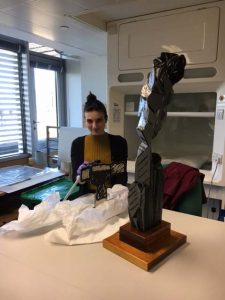In this week’s blog we bring you another edition of our volunteer voice, this time from Valentina de Riso, who volunteers in the conservation studio every week….

Valentina in the conservation studio
What is your name?
I’m Valentina de Riso.
Where are you from?
I’m from Italy and I’ve come to Scotland to study for an MSc in Comparative Literature at the University of Edinburgh.
What do you do when you are not volunteering?
I am a book lover and I have a passion for literature. When I’m not volunteering I love reading, writing short-stories and exploring the city of Edinburgh. I am also keen on old and used books, so I often happen to be in some second-hand bookshop, sniffing between pages and looking for rare books!
What roles do you carry out at the conservation studio?
I am working on a project which involves rehousing musical manuscripts and sheet music which is unbound or too flimsy to stand up on a shelf. I inspect the manuscripts and note down any damage they may have; I then catalogue them, dividing them in a logical manner between folders that go in boxes.
Why did you want to volunteer with us?
Although I am not studying conservation but I am fascinated by this area of work which I have recently discovered, and volunteering with the CRC allows me to catch a glimpse of this field. I think preserving historical records is important and I believe the knowledge acquired here is beneficial both within and also outside the conservation area.
What do you enjoy most about volunteering in the conservation studio?
I find old books and paper mesmerising. I love looking at those fragile musical manuscripts that have lived for so long, thinking that they might reach immortality thanks to the work done in the conservation studio. Also, I enjoy doing a manual work which I find absorbing, and housing and cataloguing satisfy my inner Virgo, involving precision and organisation.
What interesting/surprising fact have you learnt about conservation whilst volunteering?
I’ve learnt about the importance and necessity of the work done in conservation to preserve artistic and cultural heritage. We often use such materials for our research, dissertations and other projects, but rarely think of how such materials are now available for us, and what is their story, or who is responsible for their existence today.
I’ve also learnt about how to preserve material to reduce possible future damage, and I’ve been taught how to make boxes that fit books with specific sizes: I can now preserve the oldest books I have in this way.
What advice would you give to others who are thinking about volunteering?
I would encourage them to participate in volunteering at the CRC. It’s a great experience which allows us to see what is done behind the scenes of the University’s Library and Collections. There are many things to learn, and the conservation team is inspiring and willing to help and teach.
Describe your experience in the conservation studio in three words!
Inspiring, fascinating, enriching.
